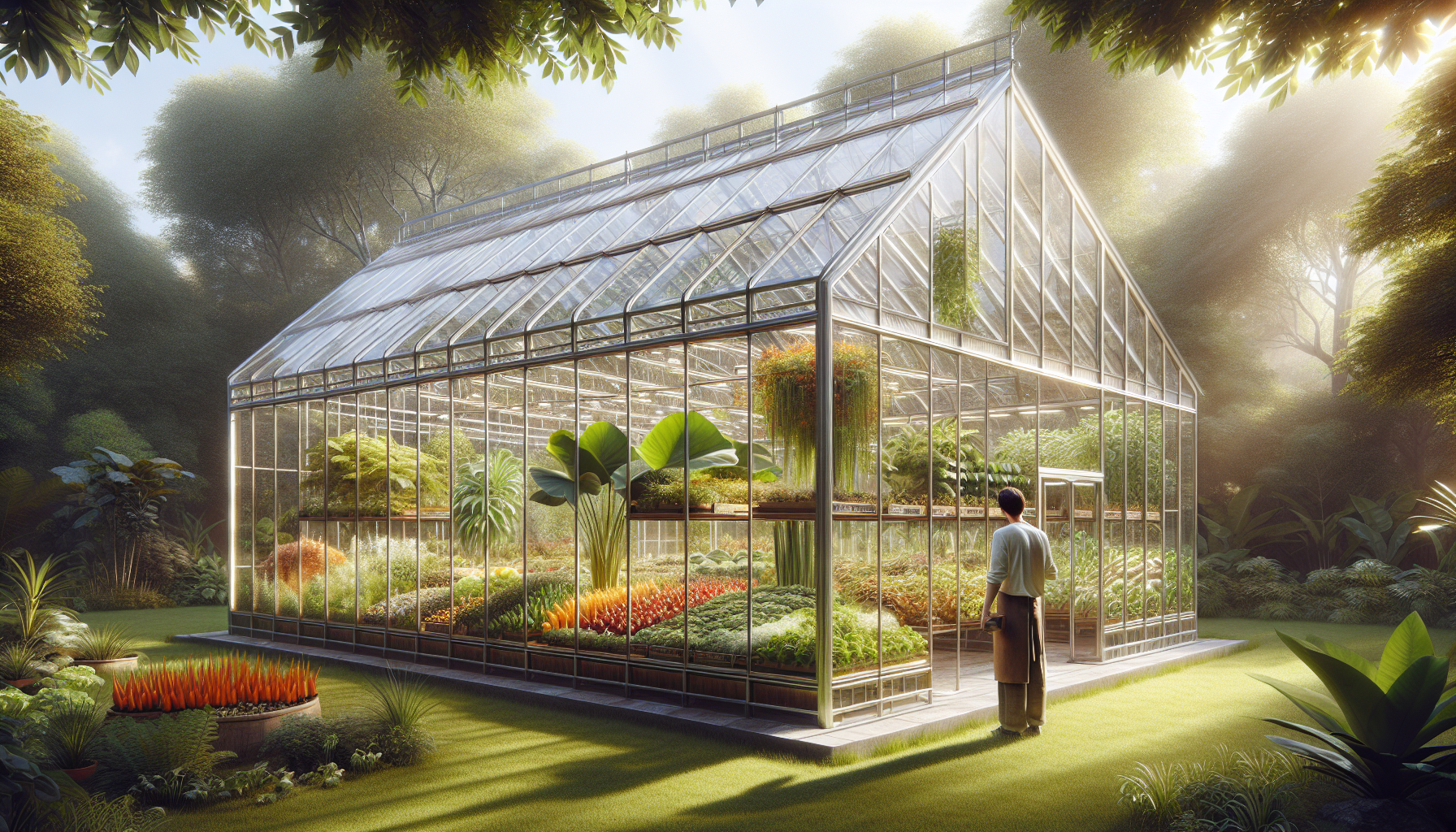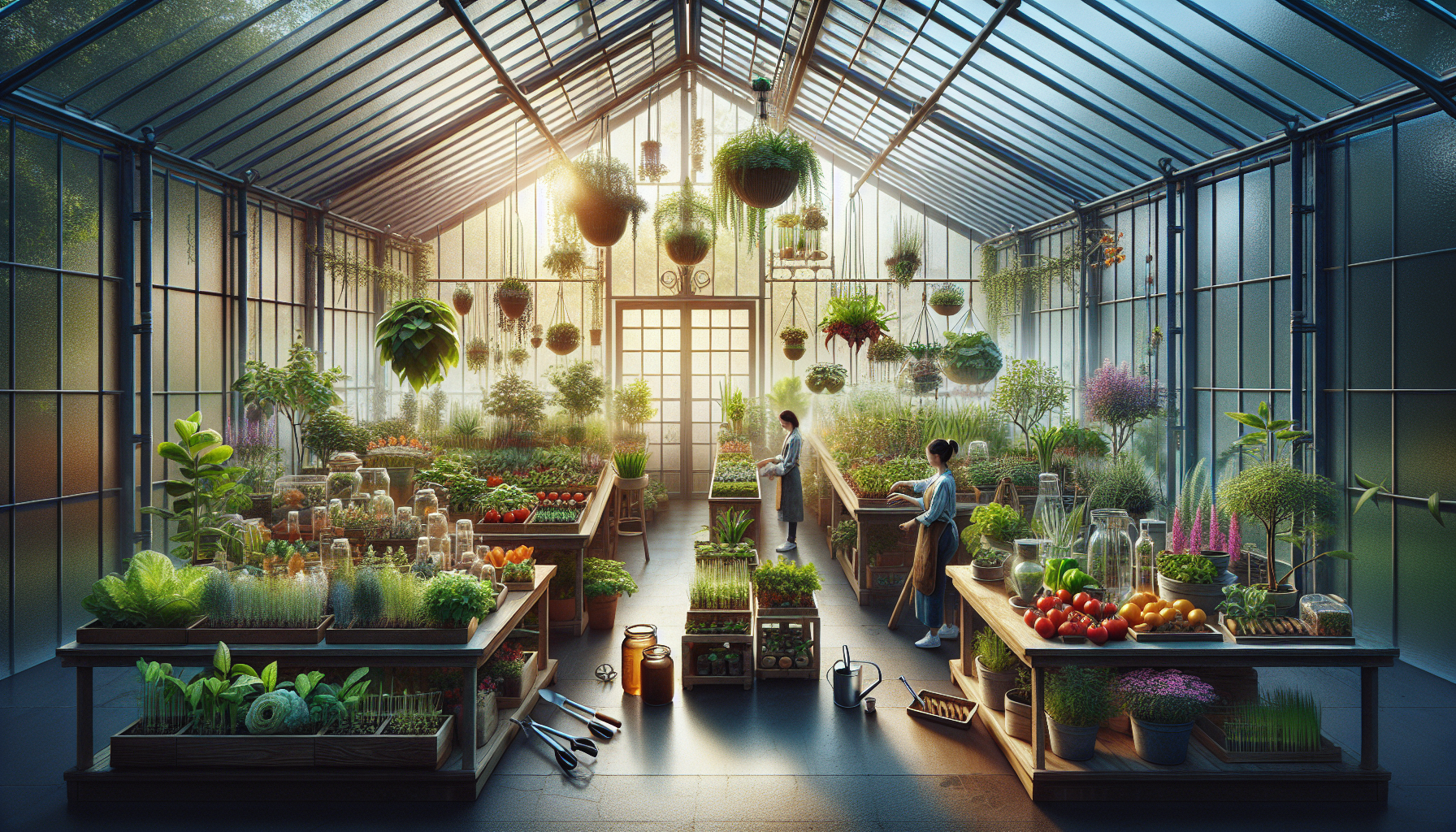
Ah, the vivid world of greenhouse gardening awaits you in the fresh pages of “Essential Greenhouse Gardening Magazine”! This monthly periodical is a must-have for both novice and seasoned gardeners alike, offering enriching knowledge, tips, and tricks for a successful greenhouse experience. From coordinating your gardening efforts with the changing seasons, to managing pests, and ensuring the optimal health and productivity of your beloved plants, this Magazine provides in-depth coverage of all things greenhouse gardening. So buckle up and prepare for an exciting adventure into this vibrant realm where green thumbs rule!
Understanding Greenhouse Gardening
Greenhouse gardening can be a hobby, a lifestyle, or even a profession. This type of gardening allows you to control your gardening environment and grow plants year-round, regardless of outside weather conditions. It enables you to experiment and explore exotic plant varieties that wouldn’t ordinarily be possible in your geographic location.
The Basics of Greenhouse Structures
A greenhouse is essentially a structure with walls and roof made primarily out of transparent material, such as glass or plastic. It provides a controlled environment for plants by allowing sunlight in while preventing excess heat escape. The structural design often varies depending on factors such as intended use, available space, and budget.
Types of Greenhouses: Pros and Cons
There are various types of greenhouses, each with its advantages and disadvantages. Some commonly used ones include A-Frame, Dome, Gothic (arch), Lean-to, and Quonset. For instance, A-Frame type is durable and offers a lot of vertical growing space but may be expensive to build. On the other hand, Quonset type is less expensive and easy to set up but may not provide as much vertical space.
Climate Control in Greenhouses
One of the most significant benefits of a greenhouse is the ability to control the climate inside it. It involves managing variables such as light, temperature, humidity, and airflow. Accurate climate control can be a matter of life or death for your plants, so understanding how to regulate these variables is crucial.
Choosing the Right Location for Your Greenhouse
The location of the greenhouse should ensure maximum sunlight exposure throughout the day. Also, consider factors such as accessibility to utilities like water and electricity, wind direction and intensity, and potential obstructions.
Getting Started with Your Greenhouse
Once you understand the basics of greenhouse gardening, it’s time to start your own greenhouse journey.
Preparation and Planning
Consider what types of plants you want to grow in your greenhouse, and this will guide your preparations. Plan the layout of your greenhouse considering the space each plant will need, their light requirements, and compatibility with other nearby plants.
Essential Tools and Equipment
Some essential tools for greenhouse gardening include thermometers, hygrometers, fans, heaters, shade cloths, grow lights, watering systems, pots and trays, and soil testing kits.
Greenhouse Kits vs. Custom-Built Options
Greenhouse kits are ideal for beginners and are available in various types, sizes, and price ranges. Custom-built greenhouses offer more flexibility and can cater to specific needs but may demand more time and resources.
Budget Considerations
The cost of starting a greenhouse can vary widely depending on the size, structure type, and equipment used. It’s vital to plan your budget in advance and account for ongoing costs like energy and water bills.

The Art of Climate Management
Effective climate management in the greenhouse can ensure optimal growth conditions for your plants.
Temperature Regulation Techniques
Accurate temperature control is crucial for a successful greenhouse. This may involve using various heating and cooling systems or strategies like ventilation, thermal mass for heat storage or shade cloths for cooling.
Humidity Control Strategies
Maintaining the right humidity levels prevents plant diseases and encourages healthy growth. This can be achieved through manual watering, automatic misting systems, or dehumidifiers.
Understanding Light Requirements
Different plants have different light requirements. Some plants need high light levels while others need low to moderate light. It is important to position plants in the greenhouse according to their light requirements.
Ventilation Systems for Disease Prevention
Adequate ventilation helps maintain airflow, prevents overheating, reduces humidity, and deters the spread of diseases. Passive ventilation features include vents and doors, while active venting may involve fans and exhaust systems.
Plant Selection for Greenhouses
Choosing the right plants for your greenhouse can make all the difference.
Best Plants for Beginners
Easy-to-grow plants suitable for beginners include lettuce, tomatoes, cucumbers, radishes, and herbs. Starting with these can help you understand the basics of plant growth and care before moving on to more challenging varieties.
Exotic Plants to Grow in Greenhouses
A greenhouse allows you to experiment with exotic or unique plant species like orchids, citrus trees, or tropical flowers that wouldn’t otherwise thrive in your local climate.
Seasonal Planting Guide
Different plants have different growing seasons. Having a seasonal planting guide helps ensure a continuous supply of harvest. It’s a schedule that tells you when to sow seeds, transplant seedlings, or harvest produce, based on the growing cycles of specific plant types.
Companion Planting Tips
Some plants grow better when planted with certain other plants. This is known as companion planting, and it can be used to aid growth, enhance flavor, or deter pests. It’s a powerful tool to make the most out of your greenhouse space.

Soil and Nutrition Management
Proper soil and nutrition management are critical to plant health and productivity.
Soil Preparation and Maintenance
Soil quality directly affects the growth and production of plants. It should be well-draining yet able to hold enough moisture and nutrients. Regular soil testing can help you understand your soil health and guide any needed amendments.
Organic vs. Inorganic Fertilizers
Both organic and inorganic fertilizers have their pros and cons. Organic fertilizers are naturally derived and improves soil structure but takes time to break down and provide nutrients. Inorganic fertilizers offer fast-acting nutrients but may harm beneficial soil organisms and the environment if used excessively.
PH Levels and Nutrient Balance
The pH level of soil influences availability of nutrients to plants. Each plant prefers a certain pH range to grow optimally. Regular testing and necessary adjustments can help maintain the right pH and nutrient balance in the soil.
Understanding Plant Feeding Schedules
Different plants require different nutrients at different stages of their life cycle. By understanding the nutrient needs and feeding schedules of your plants, you can optimize their growth and productivity.
Irrigation and Watering Solutions
Different greenhouses and plants have different watering needs.
Designing an Efficient Watering System
A good watering system caters not only to the water needs of the plants but also conserves water. Drip irrigation, soaker hoses, misting systems, and hand-watering are some of the watering methods you can utilize.
Manual vs. Automatic Watering
Manual watering gives more control and is suitable for small greenhouses. In contrast, automatic systems are more efficient for large greenhouses but require an initial investment. Both have their advantages and can be chosen based on the scale of operation, time availability, and budget.
Water Quality and Filtration
Using clean water free from contaminants like pathogens or salts is crucial to avoid plant diseases. Filtration systems can be used to purify water if necessary.
Recycling Water in A Greenhouse Environment
Collecting and reusing water is an excellent way to conserve water. It can be achieved through techniques like rainwater harvesting or using condensation.
Pest and Disease Control
Control of pests and diseases is critical to the health of your greenhouse plants.
Identifying Common Greenhouse Pests
Some common greenhouse pests include aphids, whiteflies, and spider mites. Learning to identify these pests is the first step in managing them.
Organic Pest Control Methods
Organic pest control methods, like using beneficial insects, botanical sprays, or traps, can prevent or manage pests without harming beneficial garden organisms or the environment.
Disease Prevention and Management
Keeping plants healthy with good hygiene practices, adequate ventilation and proper watering can prevent most plant diseases. Management involves diagnosing the disease early and taking prompt measures such as removing and disposing of infected plants and applying appropriate treatments.
Safe Use of Pesticides in Greenhouses
If pesticides are necessary, they should be used safely and responsibly, always following label instructions. Remember, the wrong use of pesticides can be harmful to both plants and people.
Advanced Greenhouse Technologies
Harnessing advanced greenhouse technologies can make your gardening journey easier and more efficient.
Hydroponics and Aquaponics Systems
These systems allow you to grow plants without soil. Hydroponics involves growing plants directly in a nutrient-rich water solution, while aquaponics combines aquaculture (raising fish) and hydroponics in a symbiotic environment.
Smart Greenhouse Gadgets and Sensors
Smart gadgets and sensors can automate greenhouse operations and give you real-time data about your greenhouse’s climate conditions. These tools make it easier to monitor and control variables like temperature, humidity, light, and pH levels.
LED Lighting Innovations
LED grow lights are efficient and effective for providing supplemental light in greenhouses. They come in various spectrums tailored to cater to different plant’s light needs.
Automated Climate Control Systems
Automated systems can control the greenhouse’s climate variables based on pre-set levels, making gardening more efficient and less time-consuming.
Greenhouse Maintenance and Upkeep
Regular maintenance ensures your greenhouse stays productive and increases its lifespan.
Daily and Seasonal Maintenance Routines
Daily maintenance includes watering, checking the plants for pests and diseases, and adjusting climate controls if required. Seasonal maintenance involves tasks like cleaning, removing old plants, and preparing for new seasons.
Cleaning and Disinfecting Greenhouses
Regular cleaning and disinfection prevent the buildup of pests and diseases. Use mild detergents or plant-friendly disinfectants when cleaning.
Repair and Replacement of Components
Be on the lookout for any needed repairs or replacements, such as broken panels, leaks, or malfunctioning equipment, and address them promptly to prevent bigger problems.
Winterizing Your Greenhouse
In colder regions, greenhouses need to be winterized to protect them from frost damage. This can involve adding supplemental heating, insulating, or even growing cold-hardy plants that survive the winter.
Community and Educational Resources
There is a wealth of resources available to help you on your greenhouse gardening journey.
Joining Greenhouse Gardening Groups
Gardening groups, either in person or online, can offer practical advice, support, and inspiration. It’s a great way to learn from others’ experiences and share your own.
Workshops and Training Courses
Workshops and courses provide in-depth knowledge about various aspects of greenhouse gardening. They are a good investment if you are serious about your gardening.
Online Resources and Forums
The internet is a treasure trove of gardening resources. Online forums, blogs, and tutorials can provide answers to almost any greenhouse gardening question you might have.
Subscriptions and Membership Benefits
Consider subscribing to gardening magazines or becoming a member of gardening societies. These often provide valuable up-to-date information and tips, new plant varieties, and latest gardening tools or techniques.
In conclusion, greenhouse gardening is a fascinating and rewarding endeavor. Whether you’re a beginner hobbyist or a seasoned professional, remember, every gardener has to start somewhere. And remember, “The best time to plant a tree was 20 years ago. The second best time is now!” Happy gardening!

